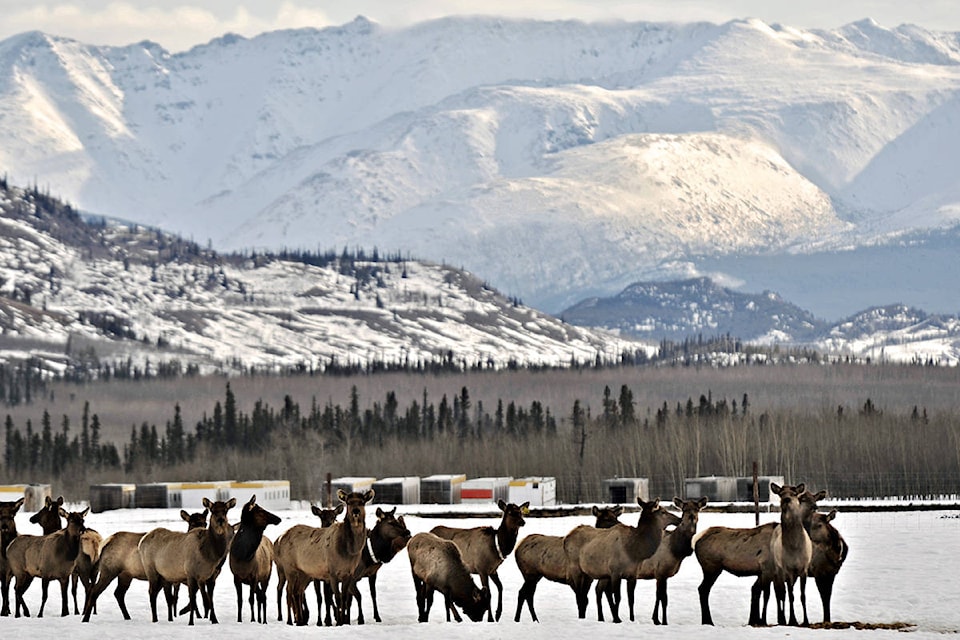A conflict between elk and farmers in his riding has Lake Laberge MLA Brad Cathers calling for changes to the way the Yukon manages the animals.
The Yukon is home to two herds of elk, the Takhini herd and the Braeburn herd. These herds are not native to the territory, but were intentionally introduced beginning in 1951 to “provide new hunting opportunities for local hunters so that harvest pressure on other ungulates would eventually be reduced,” according to the 2016 Yukon elk management plan.
The most recent numbers put herd estimates at 260 animals — 200 in the Takhini herd and 60 in the Braeburn herd. A 1990 elk management plan recommended 100 animals as a reasonable number, based on resources available for the animals, Cathers said. But that number has since ballooned, causing more agricultural conflicts.
“Farmers are experiencing property damage they feel helpless to prevent,” he said.
Part of the problem can be traced back to 2008, when the government corralled the elk and wintered them in a fenced off enclosure after winter ticks were discovered in the population.
While this essentially quarantined the animals, preventing the spread of the parasites to other native ungulates, such as moose and caribou, it also protected the herd from natural predators, allowing numbers to rise, Cathers said. This has lead to property damage and crop loss for farmers, as well as “a lot of work and a lot of money” being spent.
Elk are currently managed via a permitted hunt, which is allowed only in buffer and exclusion zones. There is a closed “core area” where the animals cannot be hunted at all, buffer areas where they are open to hunting when in season via permit, and an exclusion zone where animals can be hunted year round, a step designed to limit their range, the management plan says.
This year, Cathers said, only three permits have been granted.
“What I think is the solution to this is the increased hunting of animals and a lowering of animals’ (population) to closer to the (1990) number,” Cathers said.
Dave Andrew, a farmer who grows hay and grain and raises cattle, said he has been having problems with elk on his property since 2006. The animals knock down fences, resulting in the need for “constant repair.” The issue begins in the fall and lasts through the winter, he said, when animals paw the snow up in his fields to get at the grass. This behaviour exposes the root systems of his hay, further damaging his crops, he said.
Andrew said he had been compensated over the years through a government program designed to pay farmers like him who have suffered losses due to elk, but wasn’t sure how much money that amounted to.
Figures provided by Environment Yukon’s agriculture branch show the plan doled out $91,400 in compensation to farmers and another $84,600 over the last three years to help farmers pay for “elk prevention measures,” said department spokesperson Rod Jacob.
This money is a “band-aid solution,” Cathers said. “No one gets into farming for compensation. Farmers are trying to grow crops.”
Compounding the issue, Cathers said, is that elk cannot be shot in defense of life or property the way some other animals can be, such as bear. Instead, farmers who experience problem animals must use a conflict hunt program.
This is a time consuming and inefficient process, said Andrew, who has had to use the conflict hunt himself.
First, conservation officers come inspect a property to make sure farmers are doing everything they can to deter elk. If they find this to be the case, a hunter is called in, with special restrictions on the harvest, such as only being able to hunt in the approved field and only taking an animal from a group of elk that has five or more animals in it.
Andrew said he doesn’t understand the reasoning behind the way the government manages the elk. He said the money the government spends managing the elk herd would be better used protecting habitat for native species, since the herd isn’t serving the purpose it was originally intended for.
“As a taxpayer, I think this is crazy,” he said.
A request to Environment Yukon for the amount of money the government budgets yearly for elk management was not met by press time.
“The current structure (of elk management) doesn’t make sense from an agriculture or hunting perspective,” Cathers said.
“There are farmers in my riding who wonder at the logic of keeping an introduced species like this in the Yukon… what’s the logic of keeping this species if it’s intended purpose isn’t being met?”
Contact Lori Fox at lori.fox@yukon-news.com
